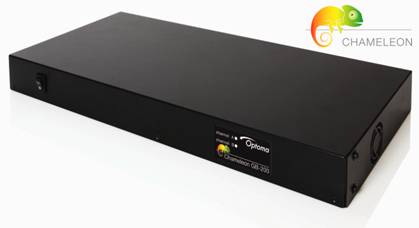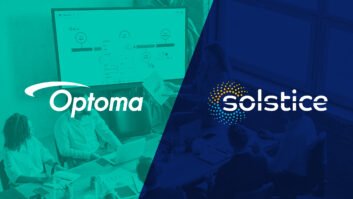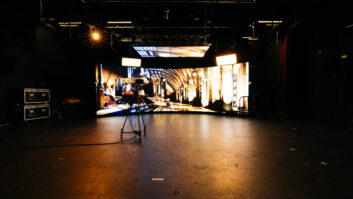
Optoma’s newly launched Chameleon GB-200 processor promises to handle edge blending and warping simply and quickly.
Targeted at museum installations, tourism attractions and exhibitions, the Chameleon GB-200 allows the overlapped edges of two or more projectors to be merged to create one seamless image. The product is also equipped with two channels, so a single processor can serve two projectors.
The processor, which was announced at ISE 2014, is the first product in the the manufacturer’s Chameleon signal processing range – which is designed to support Optoma’s ProScene projector range and provide greater control and flexibility for ambitious projects. The impressive 8m-wide edge-blended arch on the company’s ISE stand was created using four ProScene EH7700 projectors and two Chameleon GB-200 processors. Each projector generated a Full HD image; these were blended together to create a seamless image at 8K resolution across the 4.5m high arch.
Justin Halls, head of product management at Optoma, commented, “The GB-200 provides greater bandwidth and flexibility for complex and impressive installations. It is simpler to set up than alternative solutions and the overall cost of installation is lower. This is due to both time saving in installation and the fact the Chameleon GB-200 is dual channel, therefore reducing the amount of equipment needed.”
The Chameleon GB-200 includes both black level uplift and multi-region colour correction, which makes matching multiple projectors quicker and easier than ever before. In addition, it allows sub-pixel control of the alignment of both images with up to 289 individual points of adjustment on each projector enabling use on both flat and curved surfaces.
The warping capabilities of the GB-200 were also demonstrated at ISE 2014: it was used to create a 180-degree curved screen onto which two EH503 projectors beamed a high-action video game. The panoramic screen created a much wider field of view than a typical rectangular screen, giving a more immersive gaming experience.
The Chameleon GB-200 generates a single high-resolution output (approx 3,600 x 1080 pixels). This is fed to both channels of the processor via a HDMI splitter. The correct part of screen is sent to each projector and the GB-200 processor blends and warps the content to form a single bright high-resolution image.
The GB-200 processor can also be used for projector stacking, when a project needs higher brightness.
The Chameleon GB-200 can also be automated using a camera and the Optoma auto-blending tool, a trial version of which is included with the processor. This software potentially reduces the set-up time from hours to just a few minutes. The auto-blending software guides installers through a simple step-by-step process. Once connected, the camera self-calibrates, and the desired screen area is then set using simple corner adjustment. The camera feeds back the location of the dots to the processor and the blend is then enabled.
All Optoma signal processors can be controlled via a network.







